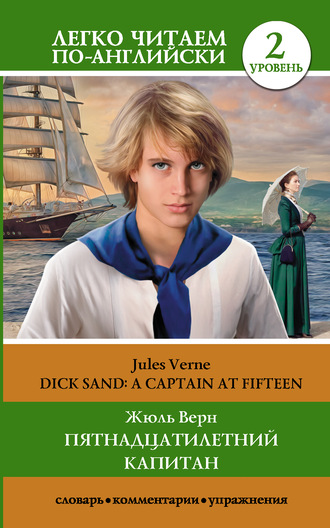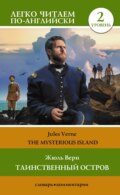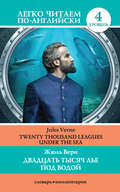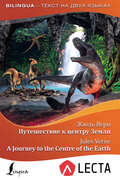
Жюль Верн
Пятнадцатилетний капитан / Dick Sand. A Captain at Fifteen. Уровень 2
Jules Verne
Dick Sand: A Captain at Fifteen
© ООО «Издательство АСТ», 2021
© Матвеев С.А., подготовка текста, комментарии, упражнения, словарь
Part I
Chapter I
The “Pilgrim”
On the 2nd of February, 1873, the “Pilgrim”, a schooner, the property of James Weldon[1], a wealthy Californian ship-owner, was ready for the whale-fisheries[2] in the southern seas.
Every season James Weldon sent his whalers both to the Arctic regions beyond Behring Straits[3], and to the Antarctic Ocean below Tasmania and Cape Horn[4]. The “Pilgrim” was onae of the best vessels of its class.
Captain Hull[5], an experienced seaman, was one of the most dexterous harpooners. The crew consisted of five sailors and an apprentice. In New Zealand, from the seamen of every nationality, and of needy emigrants, the captain could engage as many whalemen as he wanted for the season. The “Pilgrim” was on its way back. The time, indeed, for a good haul was past; the repeated and vigorous attacks upon the cetaceans made them very scarce.
The season was exceptionally unfortunate for the “Pilgrim.” At the beginning of January, Captain Hull abandoned his fishing-quarters[6]. His men had doubtful character and showed the signs of insubordination. The “Pilgrim” was directed to the north-west, towards New Zealand. On the east coast of North Island, the whole of the gang was discharged.
The ship’s crew were very dissatisfied. They were angry. Their haul was meagre. They wanted two hundred barrels more. The rascals marred the success of the expedition.
Captain Hull made every effort to engage a fresh gang; but it was too late. He was leaving Auckland, alone with his crew, when he met a request.
James Weldon brought with him his wife, his son Jack, a child of five years of age, and a relative – Cousin Benedict. They wanted to accompany Weldon on his return home to San Francisco; but little Jack was seriously ill. His father’s affairs demanded his immediate return, so he left Jack at Auckland with Mrs. Weldon and Cousin Benedict.
In three months, Mrs. Weldon was anxious to get home as soon as possible. When she heard that her husband’s vessel, the “Pilgrim”, was at Auckland, she begged Captain Hull to take her with her little boy, Cousin Benedict, and Nan, an old negress, on board the “Pilgrim”. Captain Hull gave his consent. Moreover, the captain gave Mrs. Weldon his own cabin. Everything promised well for a prosperous voyage.
Mrs. Weldon herself accompanied her husband in many voyages, and she was not afraid of a seafaring life. She was a brave, high-spirited woman of about thirty years of age, of excellent health, and for her the sea had no terrors. She knew that Captain Hull was an experienced man, in whom her husband had the utmost confidence.
Cousin Benedict accompanied her. He was about fifty. Spare, lanky, with a bony frame, with an enormous cranium, and a profusion of hair, he was one of the amiable and inoffensive savants.
He did not think of his meals until they were before him. He was utterly insensible to heat or cold. They compared him to a tree which produces scant foliage and no fruit.
But Cousin Benedict was not idle. On the contrary, he was an amateur entomologist. Every available hour he spent in the pursuit of his favourite science. This passion of his urged him to accompany Mr. and Mrs. Weldon to New Zealand.
To leave him was sheer cruelty. So when Mrs. Weldon went on board the “Pilgrim,” Cousin Benedict joined her too.
The amateur was very careful about his special box. Amongst his collection of insects were some very remarkable examples of new staphylins, a species of carnivorous coleoptera[7] with eyes above their heads. Of course Cousin Benedict insured his box at a fabulous sum. For him, it was worth far more than all the cargo of oil and whalebone.
Captain Hull met Mrs. Weldon and her party as they stepped on deck.
“Mrs. Weldon,” he said, “you take this passage entirely on your own responsibility.”
“Certainly, Captain Hull,” she answered; “but why do you say it?”
“Simply because I have no orders from Mr. Weldon,” replied the captain. “Madam, the ‘Pilgrim’ cannot afford you the comfort to which you are accustomed.”
Mrs. Weldon smiled. And the “Pilgrim” turned its head towards America.
Three days later strong easterly breezes compelled the schooner to change its course.
Chapter II
Dick Sand
Mrs. Weldon occupied the captain’s modest cabin. All the crew were civil and attentive to the wife of their employer, a master to whom they were faithfully attached. They were all natives of the coast of California, brave and experienced seamen. The only one on board who was not an American was Negoro, a cook. He was a Portuguese by birth, but spoke English with perfect fluency. The previous cook deserted the ship at Auckland. When Negoro applied for the place, Captain Hull engaged him at once.
Negoro looked about forty years of age. He was muscular; he was of middle height, and had a robust constitution. Hair was dark, his complexion somewhat swarthy. His manner was taciturn, and it was evident that he had some education. No one knew where he came from. But he made no secret of his intention to land at Valparaiso[8]. He kept himself aloof as much as possible from the rest of the crew.
So the crew of the “Pilgrim” consisted of five seamen and an apprentice. This apprentice was Dick Sand. Dick was fifteen years old; his unknown parents abandoned him at his birth.
Dick looked stoutly and strongly. His complexion was dark, but his beaming blue eyes attested his Anglo-Saxon origin.
And Dick Sand was truly courageous. At fifteen years old, he acquired the stability of a man. At an early period of his life he realized all the difficulties of life. Lithe and agile in his movements, he liked to exercise.
Whilst he was acting as cabin-boy on one of trading-vessels, Dick attracted the notice of Captain Hull, who introduced him to his employer. Mr. Weldon liked the boy and gave him education. Throughout his studies Dick Sand studied geography of the world, mathematics and the science of navigation. Finally he found himself[9] on board the “Pilgrim,” a vessel not only belonging to his benefactor, but under the command of his friend Captain Hull.
It was a pleasure to Dick Sand when he heard to his surprise that Mrs. Weldon became a passenger on board the “Pilgrim.” His devotion to the family of his benefactor was large and genuine.
Mrs. Weldon entrusted her little son to his especial charge. During the frequent periods of leisure, when the sea was fair, the apprentice was making little Jack familiar with the practice of a sailor’s craft. Mrs. Weldon’s assurance of Dick Sand’ ability and watchfulness to protect her boy was complete.
Time passed on without incident. But the wind made Captain Hull somewhat concerned; it absolutely prevented him from getting his ship into its proper course. The delay might be serious.
The Captain began to feel uneasiness. They were in a latitude far too much to the south to see a steamer going to Panama. The 2nd of February is the date at which our narrative commences.
It was about nine o’clock in the morning. Dick Sand was explaining to Jack how well the ship was ballasted, when suddenly the little fellow cried out,
“I can see something in the water!”
“Where? what?” exclaimed Dick.
“There!” said the child.
Dick fixed his gaze intently for a moment, and then shouted out lustily,
“Look out in front! There is something afloat!”
Chapter III
A Rescue
At the sound of Dick’s voice all the crew, in a moment, rushed to the deck, and Captain Hull hurried from his cabin to the bows. Mrs. Weldon, Nan, and even Cousin Benedict leaned over the starboard taffrails. Negoro did not leave his cabin, and was the only person on board who did not share the general excitement.
They saw a floating object about three miles ahead. One of the sailors declared that it looked to him like a raft. Cousin Benedict asserted that it was a huge sea-monster; but the captain soon said that it was the hull of a vessel.
In spite, however, of the convictions of the captain, Cousin Benedict was talking about some huge cetacean.
“It is certainly dead, then,” remarked Mrs. Weldon; “it is perfectly motionless.”
“Oh, that’s because it is asleep,” said Benedict.
But it was indeed the hull of a capsized ship. A quarter of an hour later and the “Pilgrim” was within half a mile of the deserted vessel. It was impossible to stand upon her deck. A few ends of cordage were all that remained of its shrouds. On the starboard flank was an enormous hole.
“The only wonder,” said the captain; “is that the vessel did not sink immediately.”
“Oh, the poor crew!” exclaimed Mrs Weldon.
“Most probably,” replied the captain, “they used the boats.”
“Is it not possible,” asked Mrs Weldon, “that anybody may still survive on board?”
“Hardly likely, madam.”
Dick Sand suddenly exclaimed,
“Hark! I hear a dog!”
Every one listened attentively. The dog was barking indeed. Was some unfortunate dog imprisoned beneath the hatchways? It was impossible at present to determine the precise truth.
Mrs Weldon pleaded,
“If it is only a dog, captain, let us save it.”
“Oh, yes, yes, mamma, we must save the dog!” cried little Jack; “I will go and get a bit of sugar for it.”
“A bit of sugar, my child, will not be much for a starved dog.”
“Then it will have my soup,” said the boy.
The vessels were now scarcely three hundred feet apart; the barking was more and more distinct, and presently a great dog barked more desperately than ever.
“Howick,” said Captain Hull, calling to the boatswain, “lower the small boat.”
The boat was lowered, and the captain and Dick, with a couple of sailors, went on board. The dog was yelping. All at once the animal become to bark with violence and furious with rage.
“What ails the brute?” exclaimed Captain Hull.
The boat was on the farther side of the wrecked ship, and the captain did not see that Negoro the cook came on to the schooner’s deck. The dog was against him. Negoro approached, and nobody saw him. Without a word or look of surprise, Negoro gazed a moment at the dog, knitted his brow, and retired.
As the boat rounded the stern of the drifting hull, the men observed that the one word “Waldeck” was painted on the aft-board, but that there was no intimation of the port to which the ship belonged. To Captain Hull’s experienced eye, however, certain details of construction gave a confirmation that it was an American ship.
The large hole near the bows indicated the place of the disastrous shock, but this aperture was five or six feet above the water.
Meantime the dog got to the centre. Here it continued to bark.
“Look at that dog!” said Dick; “I begin to think there must be somebody on board.”
“If so,” answered the captain, “he died of hunger.”
“No,” said Dick; “that dog is barking, so somebody there is alive.”
The captain and Dick called and whistled repeatedly to the dog, which jumped into the sea, and began to swim slowly towards the boat. Then the animal was lifted in.
“The poor wretch is dying of thirst!” said Dick.
Captain Hull and Dick clambered the “Waldeck”. The dog was accompanying them.
“There is nothing here; nobody here,” said the captain.
They ascended the ladder, but the dog, barking irrepressibly, began to drag them towards the stern.
They followed the dog to the poop, and there Captain Hull saw five bodies, motionless and apparently lifeless, stretched upon the floor.
Dick hastily examined them all, and emphatically declared, that they could breathe. The five unconscious men, who were all negroes, were brought safely to the boat. The dog followed, apparently satisfied.
The boat made its way back again to the “Pilgrim”. The unfortunate men were raised to the deck.
“Poor things![10]” said Mrs. Weldon, as she looked compassionately on the motionless bodies.
“But they are not dead,” cried Dick eagerly; “they are not dead; we will save them!”
“What’s the matter with them?” asked Cousin Benedict, with utter bewilderment.
“We’ll hear all about them soon,” said the captain, smiling; “but first we will give them a few drops of rum.”
Cousin Benedict smiled in return.
“Negoro!” shouted the captain.
At the sound of the name, the dog growled fiercely, and showed its teeth. The cook did not answer.
“Negoro!” again the captain shouted, and the dog became yet more angry.
Negoro slowly left his kitchen. He showed his face upon the deck. The animal made a rush at him, and wanted to seize him by the throat. The man knocked the animal back with a poker which he had in his hand.
“Do you know this dog?” asked the captain.
“Know him? No!”
“Strange!” muttered Dick to himself; “there is some mystery here.”
Chapter IV
The Survivors of the “Waldeck”
The slave-trade[11] is still extensively carried on in all parts of equatorial Africa. Year after year vessels loaded with slaves leave the coasts of Angola and Mozambique to transport their freight to many countries.
Captain Hull knew that very well. He thought that the negroes were the part of a slave-cargo which was on its way to some colony of the Pacific. And he wanted to announce that they regained their freedom on board the “Pilgrim.”
Mrs. Weldon, assisted by Nan and Dick Sand, was doing everything in her power to restore consciousness to the poor sufferers. Fresh water and some food soon helped them. The eldest of them was a man of about sixty years of age. When he regained his powers of speech, he was able to reply in good English to all the questions. In answer to Captain Hull’s inquiry whether they were not slaves, the old negro proudly stated that he and his companions were all free American Citizens from the state of Pennsylvania.
This old man communicated all the information that Captain Hull required to hear, and he related all the details of his adventures.
He said that his name was Tom. When was only six years of age he was brought from his home in Africa to the United States; but he recovered his freedom. His companions, who were all much younger than himself, were all free-born. One of them was his own son; his name was Bat (an abbreviation of Bartholomew); and there were three others, named Austin, Acteon, and Hercules.
Three years ago the five men were engaged by an Englishman who had large property in South Australia. Upon the completion of their engagement they determined to return to America. On the 5th of January, they embarked at Melbourne on board the “Waldeck.” Everything went on well for seventeen days, until, on the night of the 22nd, which was very dark, they were run into by[12] a great steamer. The scene was terrible; both masts were gone, and the brig completely heeled over on its side. Captain and crew disappeared. They were left alone upon a half-capsized and disabled hull, twelve hundred miles from the nearest land.
The boats were crushed in the collision, so that they had to await the appearance of a passing vessel.
For the next ten days the negroes were eating the food that they found in the stern cabin; but they were quite unable to obtain a drop of anything to drink. Tortured with thirst, the poor men suffered agonies. On the previous night they entirely lost consciousness.
All the outlines of Tom’s narrative were fully confirmed by the other negroes.
One other survivor of the wreck was the dog who had an unaccountable dislike to Negoro.
Dingo, as the dog was named, belonged to the fine breed of mastiffs. The animal came from the coast of West Africa, near the mouth of the Congo. The captain of the “Waldeck” get the dog two years ago. The initials S. V. were engraved upon the dog’s collar.
Dingo was very large. It was a magnificent example of his kind. Standing on hind legs, it was as tall as a man. This dog was like a panther. Its fine shaggy coat was a dark tawny colour, its long bushy tail was as strong as a lion’s. If he was angry, no doubt he became a most formidable foe.
Dingo was unsociable, but it was not savage. Old Tom said that, on board the “Waldeck,” Dingo had particular dislike to negroes; it uniformly avoided them.
The five men were profoundly grateful to their kind-hearted benefactors; poor negroes utterly resigned the hope to repay the debt which they owed their deliverers.
Chapter V
Dingo’s Sagacity
Meantime the “Pilgrim” pursued its course, it was keeping as much as possible to the east, and soon the hull of the “Waldeck” was out of sight.
Captain Hull still continued to feel uneasy. Not that for himself he cared much about the delay of a week or two in a voyage from New Zealand to Valparaiso, but he was disappointed at the inconvenience it caused to his lady passenger. Mrs. Weldon, however, did not utter a word of complaint.
The captain’s next care was to think about the accommodation for Tom and his four associates. There was no room for them in the crew’s quarters, so that their berths were under the forecastle.
After this incident of the discovery of the wreck, life on board the “Pilgrim” relapsed into its ordinary routine. The good-natured negroes were always ready to help; the strongest of them was Hercules, a great fellow, six feet high.
Hercules became at once little Jack’s friend; and when the giant lifted him like a doll in his stalwart arms, the child fairly shrieked with delight.
“Higher! higher! very high!” Jack was saying.
“There you are, then, Master Jack,” Hercules was replying.
“Am I heavy?” asked the child,
“As heavy as a feather.”
“Then lift me higher still,” cried Jack.
Besides Dick Sand and Hercules, Jack admitted a third friend to his companionship. This was Dingo. The dog was one of those animals that are fond of children. It allowed Jack to do with him almost anything he pleased. Jack found a live dog infinitely more entertaining than his old toy upon its four wheels, and his great delight was to mount upon Dingo’s back. Dingo was the delight of all the crew excepting Negoro, who cautiously avoided the animal who showed unmistakable symptoms of hostility.
But Jack did not forget his old friend Dick Sand, who devoted all his leisure time to him. Mrs. Weldon regarded their intimacy with the greatest satisfaction, and one day made a remark in the presence of Captain Hull.
“You are right, madam,” said the captain cordially; “Dick will be a first-rate sailor. He has an instinct which is a little short of genius.”
“Certainly for his age,” assented Mrs. Weldon, “he is singularly advanced. He may be able to become a captain.”
The eyes of the two speakers turned in the direction where Dick Sand was standing. He was at the helm.
“Look at him now!” said the captain; “nothing distracts him from his duty; he acts as the most experienced helmsman.”
Just at this instant Cousin Benedict emerged from the stern-cabin, and began to wander up and down the deck, peering into the interstices of the network, drawing his long fingers along the cracks in the floor.
“Well, Benedict, how are you getting on?” asked Mrs Weldon.
“I? Oh, well enough, thank you,” he replied dreamily.
“What were you looking for under that bench?” said Captain Hull.
“Insects, of course,” answered Benedict; “I am always looking for insects.”
“But don’t you know, Benedict,” said Mrs. Weldon, “that Captain Hull does not allow any vermin on the deck of his vessel?”
Captain Hull smiled and said, -
“Mrs Weldon is very complimentary.”
Cousin Benedict shrugged his shoulders.
“However,” continued the captain, “I dare say down in the hold you can find some cockroaches.”
“I can see, sir,” replied Benedict, “that you are not an entomologist!”
“Not at all,” said the captain good-humouredly.
“Are you not satisfied,” Mrs. Weldon interposed; “with the result of your explorations in New Zealand?”
“Yes, yes,” answered Benedict, with reluctance; “I must not say I was dissatisfied. But, you know, an entomologist is always craving for fresh additions to his collection.”
While he was speaking, Dingo came and jumped on Benedict, and began to fawn on him.
“Get away, you brute!” he exclaimed, thrusting the dog aside.
“Poor Dingo! good dog!” cried Jack, running up and taking the animal’s huge head between his tiny hands.
“Your interest in cockroaches, Mr. Benedict,” observed the captain, “does not seem to extend to dogs.”
“This creature,” answered Benedict; “ disappointed me.”
“What do you mean? You cannot catalogue it?” asked Mrs Weldon laughingly.
“I understand that this dog was found on the West Coast of Africa,” replied Benedict, “and I hoped that it had some African insects in its coat. I searched its coat well, over and over again, but I could not find a single specimen.”
Captain Hull and Mrs. Weldon laughed.
Such were the conversations throughout the monotonous hours of smooth sailing, while the “Pilgrim” was making its headway to the east.
Cousin Benedict began to teach Hercules entomology. He was studying the extensive collection of stag-beetles, tiger-beetles and lady-birds.
Mrs. Weldon was giving her attention to the education of Master Jack. She was teaching her son to read and write, Dick Sand taught him arithmetic. The child made a rapid progress. Mrs. Weldon used a set of cubes, on the sides of which the various letters were painted in red. There were more than fifty cubes, which, besides the alphabet, included all the digits. It was astonishing how quickly the child advanced, and how many hours he spent in the cabin and on deck. Mrs. Weldon was very satisfied.
On the morning of the 9th an incident occurred. Jack was half lying, half sitting on the deck, amusing himself with his letters. He made a word with which he intended to puzzle old Tom. All at once, Dingo, who was gambolling round the child, made a sudden pause, lifted his right paw, and wagged his tail convulsively. Then the animal seized a capital S in his mouth, and carried it some paces away.
“Oh, Dingo, Dingo! you mustn’t eat my letters!” shouted the child.
But the dog came back again, and picked up another letter. This time it was a capital V. Jack uttered an exclamation of astonishment which brought to his side not only his mother, but the captain and Dick. Jack cried out in the greatest excitement that Dingo knew how to read.
Dick Sand smiled and stooped to take back the letters. Dingo snarled and showed his teeth, but the apprentice was not frightened. He replaced the two blocks among the rest. Dingo in an instant pounced upon them again, and laid a paw upon each of them.
“It is very strange,” said Mrs. Weldon; “he has picked out S V again.”
“S V!” repeated the captain thoughtfully; “are not those the letters that form the initials on his collar?”
He turned to the old negro, and continued,
“Tom didn’t you say that this dog did not always belong to the captain of the ‘Waldeck’?”
“I often heard from the captain,” replied Tom, “that he found the dog at the mouth of the Congo[13].”
Mrs. Weldon asked, -
“Do you recall these letters, captain?”
“Mrs. Weldon,” the captain replied; “I can associate them with the fate of a brave explorer.”
“Whom do you mean?” said the lady.
“In 1871, just two years ago,” the captain continued, “a French traveller set out to cross Africa from west to east. His starting-point was the mouth of the Congo, and his exit was Cape Deldago, at the mouth of the River Rovouma[14]. The name of this man was Samuel Vernon. These letters – Vernon’s initials – are engraved on Dingo’s collar.”
“What do we know about this traveller?” asked Mrs. Weldon.
“Nothing. I think that he failed to reach the east coast. He died upon his way, or he was made prisoner[15] by the natives. Did this dog belong to him?”
“But you have no reason to suppose, Captain Hull, that Vernon ever owned a dog?”
“I never heard of it,” said the captain; “but the dog knows these letters. Look at the animal, madam! It does not only read the letters for himself, but invites us to come and read them with him.”
Whilst Mrs. Weldon was watching the dog with much amusement, Dick Sand asked the captain whether the traveller Vernon started on his expedition quite alone.
“That is really more than I can tell you, my boy,” answered Captain Hull.
Meanwhile Negoro quietly appeared on deck. The dog caught sight of the cook and began to bristle with rage. Negoro withdrew immediately to his room.
The incident did not escape the captain’s observation.
“No doubt,” he said, “there is some mystery here.”
“Don’t you think, sir, it’s strange that this dog knows the alphabet?”
“My mamma told me about a dog whose name was Munito, who could read as well as a schoolmaster, and could play dominoes,” said Jack.
Mrs. Weldon smiled.
“I am afraid, my child, the dog’s master, who was a clever American, taught Munito some curious tricks.”
“The more I think of it, the more strange it is,” said Captain Hull; “Dingo evidently has no acquaintance with any other letters except the two S V. Some circumstance which we cannot guess made the animal familiar with them.”
“What a pity Dingo cannot talk!” exclaimed the apprentice.







